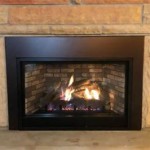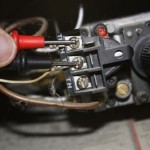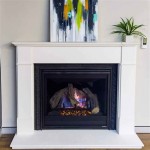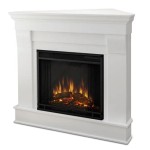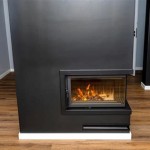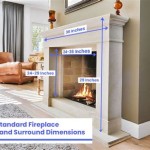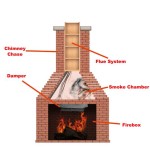Building A Fake Fireplace: A Comprehensive Guide
The allure of a fireplace is undeniable. It evokes feelings of warmth, comfort, and a sense of home. However, not every dwelling is equipped with a traditional fireplace. Whether due to structure, budget, or simply a desire for a cleaner alternative, building a fake fireplace can be an excellent solution. This option offers the aesthetic benefits of a fireplace without the complexities of installation, maintenance, and safety concerns associated with wood-burning or gas-fueled models.
Building a fake fireplace, also referred to as a faux fireplace or a decorative fireplace, involves constructing a non-functional structure that mimics the appearance of a real fireplace. These installations typically consist of a surround or mantel, a firebox opening, and potentially an insert that simulates flames or embers. The level of detail and complexity can range from a simple, minimalist design to an elaborate, historically accurate replica. The project can be completed by DIY enthusiasts or outsourced to professional carpenters or contractors, depending on the desired outcome and skill level.
The materials used to construct a fake fireplace vary widely. Common choices include wood (such as MDF, plywood, or solid hardwood), brick veneer, stone veneer, concrete, and metal. The selection of materials depends on the desired style, budget, and structural requirements. The project also necessitate various tools, including measuring tapes, saws, drills, levels, hammers, sandpapers, and potentially power tools such as nail guns or miter saws.
Careful planning is crucial for a successful fake fireplace build. This includes determining the desired location, style, dimensions, and features of the fireplace. It also involves considering the overall aesthetic of the room and ensuring that the fake fireplace complements the existing decor. Thorough planning will minimize errors, reduce material waste, and help achieve a satisfactory result.
Key Point 1: Planning and Design Considerations
Effective planning is the cornerstone of any successful building project, and a fake fireplace is no exception. The initial stage requires careful consideration of several factors, including location, style, dimensions, and integration with the existing room. Failure to adequately address these aspects can result in a fireplace that looks out of place, is disproportionate to the room, or fails to achieve the desired aesthetic effect.
The location of the fake fireplace is paramount. It should be positioned in a location that naturally draws attention, such as a focal wall in the living room or bedroom. Considerations should be given to existing architectural features, such as windows, doorways, and built-in shelving. Ensuring that the fake fireplace does not obstruct walkways or interfere with the functionality of the room is crucial. Wall space must be sufficient enough to achieve the intended size without making the surrounding area feel cramped.
The style of the fake fireplace should complement the existing decor and architectural style of the room. Options range from traditional and ornate designs to modern and minimalist styles. Understanding the character of the space is required to select a style that enhances the overall aesthetic. For example, a traditional-style home might benefit from a fireplace with intricate moldings and a classic mantel, while a modern home might be better suited for a sleek, minimalist design with clean lines.
Dimensioning the fake fireplace is another critical aspect of the planning process. The dimensions should be proportionate to the size of the room. A fireplace that is too large can overwhelm a small space, while a fireplace that is too small can appear insignificant in a large room. Precise measurements of the wall space and ceiling height are necessary to determine the appropriate dimensions. Moreover, the dimensions of the firebox opening should be considered, as it will influence the visual impact of the fireplace. Think about the size of the desired decorative element inside the hearth - candles, wooden logs, electrical firebox.
Integration with the existing room involves considering how the fake fireplace will interact with the surrounding furniture and accessories. The color and texture of the fireplace should complement the existing color palette of the room. The placement of furniture should be arranged to create a comfortable and inviting seating area around the fireplace. Accessories, such as artwork, mirrors, and plants, can be used to enhance the visual appeal of the fireplace and create a cohesive look.
Key Point 2: Materials and Construction Techniques
The selection of materials and the application of sound construction techniques are essential for building a durable and aesthetically pleasing fake fireplace. The choice of materials depends on the desired style, budget, structural requirements, and skill level of the builder. Appropriate construction techniques ensure that the fireplace is structurally sound, visually appealing, and long-lasting.
Wood is a versatile and commonly used material for building fake fireplaces. MDF (Medium-Density Fiberboard) is a cost-effective option that is easy to cut, shape, and paint. Plywood is another popular choice due to its strength and stability. Solid hardwood, such as oak or maple, provides a more durable and luxurious option. The selection of wood depends on the desired aesthetics and the budget constraints.
Brick veneer and stone veneer offer a realistic and visually appealing option for creating a rustic or traditional fireplace. These materials are typically adhered to a wooden or concrete frame using mortar or adhesive. The selection of brick or stone veneer depends on the desired color, texture, and style.
Concrete can be used to create a modern and industrial-style fireplace. Concrete fireplaces can be cast in place or pre-fabricated. The material's versatility is the main draw as it can be formed into various shapes and textures. Concrete can also be stained or sealed to achieve a desired finish.
Metal, such as steel or aluminum, can be used to create a sleek and contemporary fireplace. Metal fireplaces are often lightweight and durable. The material is frequently used to create a firebox surround or mantel.
Construction techniques involve several steps, including framing, sheathing, cladding, and finishing. Framing involves building a structural framework out of wood or metal to support the fireplace. Sheathing involves covering the framework with plywood or OSB (Oriented Strand Board) to provide a solid surface for cladding. Cladding involves applying the chosen material, such as wood, brick veneer, or stone veneer, to the sheathing. Finishing involves painting, staining, or sealing the fireplace to protect it from the elements and enhance its appearance.
Adhering to standard construction practices, such as using proper measurements, ensuring level surfaces, and using appropriate fasteners, is crucial for building a structurally sound and visually appealing fake fireplace. This includes using a level to ensure that the framework is straight and even, using a measuring tape to accurately cut the materials, and using screws or nails to securely fasten the components together.
Key Point 3: Firebox Inserts and Decorative Elements
The firebox insert and decorative elements are integral components of a fake fireplace, as they create the illusion of a real fire and enhance the overall aesthetic appeal. The selection of the firebox insert and decorative elements depends on the desired effect, budget, and personal preferences. These elements can range from simple candles to sophisticated electric fireplace inserts.
Electric fireplace inserts are a popular choice for fake fireplaces, as they provide a realistic flame effect without the need for venting or fuel. These inserts use LED lights and reflective materials to create the illusion of flickering flames and glowing embers. Electric fireplace inserts are available in a variety of sizes, styles, and features, including adjustable flame height, heat output, and remote control operation.
Candles are a simple and inexpensive way to create a warm and inviting ambiance in a fake fireplace. Candles can be arranged in the firebox opening to simulate the appearance of a fire. The choice of candle type, size, and scent depends on the desired effect.
Faux logs are another popular decorative element for fake fireplaces. These logs are typically made of resin or ceramic and are designed to look like real wood. Faux logs can be arranged in the firebox opening to create a realistic wood-burning fireplace effect. The logs sometimes come with a glowing element to simulate embers.
Fireplace screens and grates can be used to enhance the authenticity of a fake fireplace. These accessories are typically made of metal and are designed to look like real fireplace screens and grates. Fireplace screens and grates can be placed in front of the firebox opening to create a more realistic appearance.
Additional decorative elements can be used to personalize a fake fireplace and enhance its visual appeal. These elements include artwork, mirrors, plants, and decorative objects. Artwork can be hung above the mantel to create a focal point. Mirrors can be used to reflect light and create the illusion of space. Plants can be used to add a touch of greenery and life. Decorative objects, such as vases, candles, and books, can be arranged on the mantel to add character and personality.
Proper installation of the firebox insert and decorative elements is crucial for achieving the desired effect and ensuring safety. Electric fireplace inserts should be installed according to the manufacturer's instructions. Candles should be placed on a stable surface and kept away from flammable materials. Faux logs should be arranged in a realistic manner and should not block the ventilation of the fireplace. Fireplace screens and grates should be securely attached to the fireplace. The goal is to provide an aesthetic appeal while ensuring a safe and functional set up.
Ultimately, building a fake fireplace is a project that relies on careful planning, skillful execution, and attention to detail. The end result can be a beautiful and functional addition to the home, providing the ambiance and charm of a traditional fireplace without the associated complexities and costs. By carefully considering the design, materials, construction techniques, and decorative elements, a successful fake fireplace can be built, enhancing the aesthetic appeal and comfort of any living space.

Diy Faux Fireplace For Under 600 The Big Reveal Bless Er House

25 Diy Faux Fireplace Ideas Build Your Own Fake Suite 101

How To Build A Faux Fireplace With Storage Addicted 2 Diy

20 Easy Diy Faux Fireplace Ideas To Build Joyful Derivatives

How To Build A Faux Fireplace Mantel And Surround The Home Depot

Diy Faux Fireplace Mantel With Tile And Brick

How To Build A Faux Fireplace Engineer Your Space

20 Easy Diy Faux Fireplace Ideas To Build Joyful Derivatives

15 Stunning Diy Fake Fireplace Ideas To Make Now Twelve On Main

How To Build A Cozy Diy Faux Fireplace Start At Home Decor
Related Posts

